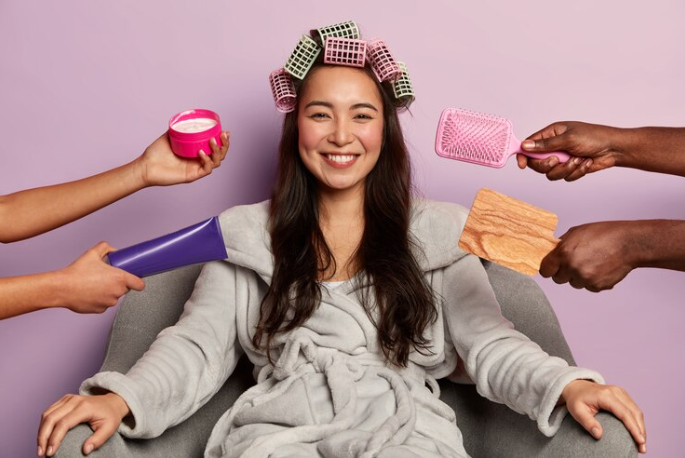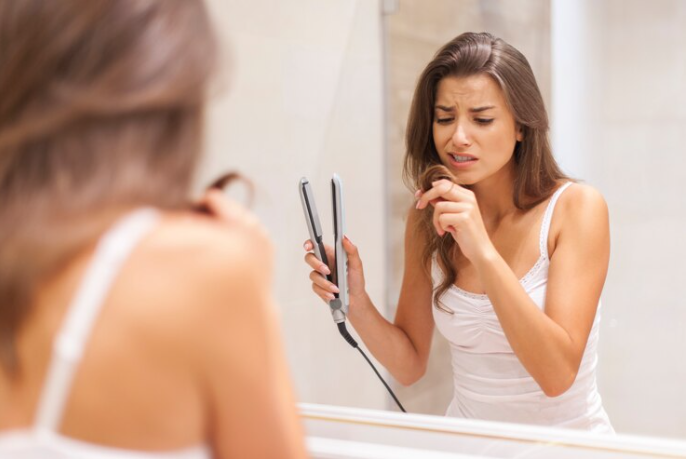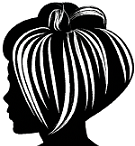“Managing Combination Hair: Balancing an Oily Scalp with Dry Ends” hair care routine for oily scalp and dry ends
hair care routine for long healthy and shiny hair. Having a unique hair type, with an oily scalp and dry ends, can pose a set of challenges. Yet, it’s important to recognize that you’re not alone in this struggle. There are many individuals dealing with the reverse issue, with a dry scalp, and neither scenario is without its difficulties.
Fortunately, there are a plethora of effective tips, tricks, and products that can help you tackle the dual challenge of keeping your oily scalp clean and nourishing your dry ends. Let’s explore some expert strategies for maintaining healthy and balanced hair:
Do You Have Combination Hair: Decoding the Oily Scalp and Dry Ends Dilemma”

Recognizing the unique hair type that combines an oily scalp with dry ends is crucial to tailoring the right care routine. How do you know if you fall into this category? Here’s a handy guide to help you identify this combination hair type:
The Telltale Signs: If you’ve noticed that your hair ends are dry, brittle, and may even sport split ends, while your scalp quickly becomes oily and greasy within just a day or two of washing, you likely have the elusive combination of an oily scalp and dry ends.
Color and Bleach Effects: If you’ve subjected your hair to color treatments, particularly bleach, it’s more likely to lead to this particular hair dilemma. These treatments can strip your locks of their natural oils, leaving your ends parched and your scalp overcompensating with oil production.
Scalp Signals: An oily scalp comes with its own set of signals. It can often feel itchy and may leave your hair looking dull, lifeless, slick, and somewhat stringy. It’s the sort of look that you might be eager to part ways with.
Ends in Distress: Dry ends, on the other hand, come with their set of woes. They tend to appear frizzy, damaged, and generally uncooperative, often ruining the overall aesthetic of your hair.
The combination of an oily scalp and dry ends is usually quite easy to spot. The key is early recognition, as it’s the first step towards restoring your locks to their best potential. Understanding the unique challenges of your hair will empower you to embark on a hair care journey that can help you achieve the vibrant, healthy hair you desire.
In summary, the oily scalp and dry ends dilemma isn’t a riddle without a solution. By being aware of the specific characteristics of your hair and its unique challenges, you’re better equipped to embrace a tailored hair care routine that will keep your hair looking and feeling its very best.
What’s Behind Oily Roots and Dry Ends: The Culprits Unveiled

Oily roots and dry ends are the challenging duo that many of us grapple with. Let’s delve into the causes of this perplexing hair conundrum:
Oily Roots: Oily roots primarily stem from the sebaceous glands residing on your scalp. These glands produce sebum, a natural oil that’s meant to nourish and protect your hair. However, when they go into overdrive, you’re left with greasy, shiny hair near the scalp. Here’s what fuels these oily roots:
Genetics: Some individuals simply have sebaceous glands that are more active, making them prone to oily roots.
Hair Products: Certain hair care products, especially those infused with essential oils or heavy ingredients, can exacerbate oiliness. While these ingredients may be nourishing for dry ends, they can be a bit too much for your scalp.
When left unaddressed, an oily scalp can lead to unwelcome complications like dandruff, fungal issues, or even seborrheic dermatitis, a condition characterized by scaly patches on the scalp, which may also contribute to hair loss.
Dry Ends: Dry ends, like their oily counterparts, can be attributed to various factors, such as:
Overwashing: Frequent shampooing can strip your hair of its natural oils, leaving the ends parched and fragile.
Sun Exposure: Excessive sun exposure can lead to dryness, making your hair prone to brittleness and split ends.
Hair Type: Certain hair types, like curly or coarse hair, are more susceptible to dry ends due to their natural texture.
Weather: Harsh environmental conditions, especially low humidity, can contribute to moisture loss in your hair.
Drying Products: Heat styling tools, such as hairdryers and straighteners, can deplete the moisture content in your hair, causing dry ends.
Now, here are some pro tips for addressing these hair dilemmas:
Balanced Washing: Find a washing frequency that suits your hair type, avoiding excessive shampooing.
Hair Protection: Shield your hair from excessive sun exposure and environmental elements with hats or UV-protective products.
Moisturizing Products: Use hydrating conditioners and hair masks to nourish your ends.
Trimming: Regular trims help remove dry, split ends, promoting healthier hair growth.
In conclusion, understanding the roots of oily roots and dry ends empowers you to take control of your hair care routine. By striking the right balance and adopting a holistic approach to hair care, you can bid adieu to these common hair woes and embrace locks that are both healthy and beautiful.
Mastering the Oily Scalp and Dry Ends Dilemma: 11 Expert Tips for Perfect Hair

Taming the challenge of an oily scalp coupled with dry ends doesn’t have to be an uphill battle. With insights from hair professionals, specialized products, and ingenious hacks, you can transform your hair care routine and bestow a new lease of life upon your locks. Your scalp and hair are about to thank you for these game-changing tips:
1. Brush Smartly with the Right Tool: It’s time to debunk the myth that brushing makes oily hair worse. In fact, brushing helps redistribute your natural oils from the scalp to the ends, providing a balanced moisture level. Choose the right hairbrush; boar bristle brushes work wonders for even oil distribution. The length of bristles should match your hair thickness.
2. Adopt Continuous Strokes: Change your brushing technique to ensure oils are evenly spread throughout your hair. Brush from roots to tips, stimulating blood flow, removing product buildup, and enhancing your hair’s overall health. Avoid over-brushing, as it can trigger excess oil production.
3. Strategic Shampooing and Conditioning: Divide and conquer your combination hair with a strategic routine. Shampoo your roots to remove buildup and follow with a conditioner applied mainly to the ends. Let the conditioner sit for a few minutes while you complete your shower routine for enhanced nourishment.
4. Choose the Right Products: Opt for hair products that are free of sulfates, mineral oil, parabens, and other harmful ingredients. A quality product line designed for your needs, such as the Vegan-certified Wetline Haircare Collection, ensures a healthier choice for your hair and extensions.
5. Wash Less Often: Resist the urge to over-wash oily hair. Frequent washing strips your hair of natural oils, prompting your scalp to produce more. Find the right balance for your hair type and wash accordingly.
6. Embrace Dry Shampoo: When you need a quick refresh, dry shampoo is your ally. It absorbs excess oil at the roots without a full wash, giving your natural oils time to redistribute and adding volume to your hair. Consider making your DIY dry shampoo using ingredients like baking soda, arrowroot, or clay.
7. Hydrate with Hair Oil: Adding hair oil to the ends or mid-lengths restores moisture to dry ends without making the scalp greasier. A lightweight option like Luminous Shine Hair Oil with avocado and kukui nut oils can tame frizz and prevent moisture loss.
8. Consider a Trim: A haircut can do wonders for combating oily roots and dry ends. Even an at-home trim can help.
9. Hands Off: Touching your hair with oily fingers can exacerbate the issue. Keep your hands away from your locks to prevent further oil transfer.
10. Indulge in a Scalp Scrub: A scalp scrub acts as an exfoliant, removing dead skin, dirt, and buildup. You can even create DIY hair scrubs with common household ingredients.
11. Limit Heat Styling: Heat styling can amplify oil transfer from the scalp to the hair. Opt for styles that involve less heat or use a heat protectant to shield your hair.
Incorporate these tips into your hair care routine, and you’ll soon witness the transformation of your combination hair into a balanced, radiant mane. Your hair will thank you with vitality, health, and a flawless shine!
Top Product Picks for Managing Oily Roots and Dry Ends
When it comes to managing the delicate balance of oily roots and dry ends, the right hair care products can make all the difference. Here are our top recommendations:
Best Shampoo for Oily Scalp and Dry Ends:
Charcoal Detox Shampoo
Bid farewell to excess grease, oil, and impurities with the Charcoal Detox Shampoo. This detoxifying powerhouse is your go-to solution for cleansing and rejuvenating your hair.
Key ingredients:
Activated charcoal: Draws out impurities from deep within the pores without stripping away healthy oils.
Organic apple cider vinegar: Rids your hair of buildup and restores a healthy pH level, tackling dandruff and other scalp concerns.
Aloe vera, organic baobab oil, and vitamin B-5: Ensure your strands remain hydrated, preventing them from becoming dry and lifeless.
Choosing a vegan hair care product like this shampoo means you can give your hair the thorough cleansing it deserves without leaving it feeling brittle or straw-like.
Best Conditioner for Oily Scalp and Dry Ends:
High Gloss Smoothing Conditioner
Following your wash, a quality conditioner is essential to moisturize, mend split ends, and combat frizz. The High-Gloss Smoothing Conditioner offers all these benefits and more, leaving your hair cleansed, conditioned, smooth, and gorgeously shiny.
Key ingredients:
Organic shea butter, grape seed oil, and vitamin B-5: Provide deep moisture, soothing dry ends.
Linseed oil: Promotes strong and shiny hair growth.
Certified vegan and cruelty-free: This environmentally-friendly conditioner lets you care for your hair with a clean conscience.
Best Hair Mask for Oily Scalp and Dry Ends:
Length Repairing Hair Mask
If your dry ends are in desperate need of rescue, a hair mask can work wonders, restoring moisture, softness, and shine. The Length Repairing Hair Mask is your ticket to instant transformation.
Key ingredients:
Organic baobab oil, caryocar brasiliense fruit oil, and vitamin B-5: Deeply condition and revitalize your hair.
Organic jojoba oil and coconut oil: Promote healthier, stronger hair.
Vegan formula: Lightweight and non-greasy, suitable for both natural hair and hair extensions.
Incorporate these stellar products into your hair care routine, and you’ll be well on your way to conquering the oily scalp and dry ends challenge, all while pampering your hair with the care it truly deserves. Your locks will thank you with a healthy, lustrous, and balanced look.
FAQs about hair care routine for long healthy and shiny hair
What should I do to avoid an oily scalp but dry ends?
Use a sulfate-free shampoo and conditioner. Sulfates can strip natural oils from your scalp and make your ends drier.
Focus shampoo primarily on your scalp to address the oiliness and condition the ends to combat dryness.
Avoid over-washing, which can further dry out your ends. Opt for every 2-3 days or as needed.
How often should I wash my hair if I have an oily scalp but dry ends?
Aim for 2-3 times a week. Overwashing can exacerbate the dryness in the ends and stimulate more oil production in the scalp.
What hair oil is good for an oily scalp and dry ends?
Lightweight, non-comedogenic oils like jojoba oil, argan oil, or grapeseed oil can be used on the ends to provide moisture without making your scalp oilier. Apply sparingly.
How do you treat combination hair?
Use a gentle, sulfate-free shampoo on your scalp and a hydrating conditioner on the ends.
Try a clarifying shampoo occasionally to remove excess oil and product buildup from the scalp.
Avoid heat styling tools and products with alcohol that can further dry out your hair.
Should I avoid oil if I have an oily scalp?
You can use lightweight oils on the ends of your hair to combat dryness without making your scalp oilier. Just be mindful of the quantity you use and avoid applying oil directly to your scalp.
How long does it take to train your hair to not be greasy?
It can take a few weeks to a couple of months for your hair to adjust to a less frequent washing schedule. Be patient and consistent in your hair care routine.
How do you refresh greasy hair without dry shampoo?
Use a lightweight conditioner on the ends to add moisture and freshness without affecting your scalp.
Try rinsing your hair with water and gently massaging your scalp to distribute natural oils.
Use a blotting paper or tissue to absorb excess oil from your scalp.
How can I keep my hair fresh all day?
Carry a travel-sized dry shampoo or oil-absorbing hair powder to touch up during the day.
Avoid touching your hair with oily hands, as this can transfer more oil to your hair.
Consider using a silk or satin pillowcase, which can help reduce friction and oil absorption while you sleep.

